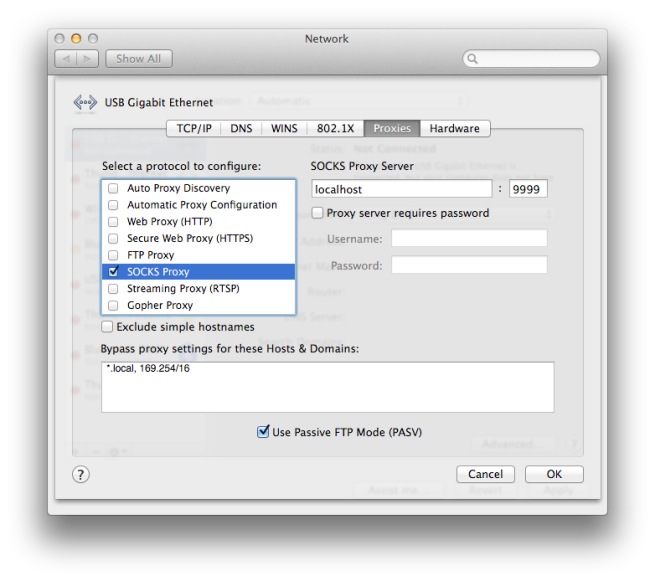Inspiriert von der Anleitung von Freewave, die zeigt, wie man in einem unverschlüsselten WLAN (wie Freewave es an vielen Orten in ganz Österreich anbietet) dafür sorgen kann, dass nicht unabsichtlich Apps mit dem Internet sprechen, habe ich hier ein paar Anpassungen zusammengestellt, um das Gleiche mit SSH und SOCKS zu nutzen.
Wenn man Zugang zu einem Server im Internet per SSH hat (eigener Webserver, Uni-Account), kann man sich einfach eine sichere Verbindung (zumindest bis zu ebendiesem Server, aber es geht ja eigentlich nur darum die WLAN-Signale zu verschlüsseln) basteln.
Man startet ein Terminal-Fenster und gibt Folgendes ein:
ssh -D9999 username@mein.server
Mit dem Schalter -D<port> wird ein SOCKS-Proxy gestartet, der auf localhost:<port>, in diesem Fall auf localhost:9999, lauscht. Man lässt dann das Terminal-Fenster sowie die Verbindung so lange offen, solange man den Proxy verwenden will.
Dann konfiguriert man sein OSX so (in den Systemeinstellungen unter “Netzwerk”), dass es den SOCKS-Proxy verwendet:
und letztlich passt man dann noch die Regeln an, wie sie in der Anleitung von Freewave gezeigt werden:
Der Unterschied besteht in der Regel für “Terminal”, die pppd und racoon ersetzt. Am einfachsten erstellt man die, indem man die Regel erstmal einfach weg lässt und die “alle ausgehenden”-Regel auf “Nachfragen” stellt. Dann das ssh Kommando ausführen, Little Snitch fragt nach, was es tun soll. Daraufhin erlaubt man die Verbindung für immer und stellt danach die “alle ausgehenden”-Regel wieder auf “Verbieten” zurück. (bei mir gibt es hier 2 Regeln, weil ich je nach Anwendungsfall 2 verschiedene Server verwende)
Übrigens: Ich fand die Bezeichnungen “Ohne VPN” und “Mit VPN” verwirrend, deswegen hab ich die bei mir “Potenziell Unsicher” bzw. “Vertrauenswürdig” genannt.
Insgesamt ist leider schade, dass mit einer solchen Konstruktion die ganzen Regeln, die man mehr oder weniger mühsam unter “Vertrauenswürdig” erstellt hat, nicht gelten, während man “Potenziell Unsicher” aktiviert hat: es geht einfach alles durch SSH, auch was man unter “Vertrauenswürdig” verboten hat.


